

Archaeologists in Egypt unearthed what is believed to be the oldest known gym membership, written in Greek nearly 1,800 years ago on a fragment of papyrus.
Discovered in the sandy countryside near Oxyrhynchus, the document offers a rare glimpse into the structured world of professional athletes during Roman rule. This Greek text, preserved by Egypt’s arid climate, reveals the administrative side of ancient athletic organizations and highlights the enduring influence of Greek cultural practices in Roman Egypt.
This small archaeological discovery from many years ago is a living piece of history that shows us the love for sports that people in Ancient Greece and Rome had. This is why they were so meticulous and organized, in a way very similar to today’s gym memberships.
Gym membership 1818 years ago:
“Herminus has paid his entrance fee and is now a member of the sacred boxing society devoted to Heracles”@BLMedieval Papyrus 1178 to mark #NationalFitnessDay #wednesdaythought #WednesdayMotivation #gymlife #gymmotivation pic.twitter.com/daumD3egB5— peter toth (@petetoth) September 21, 2022
This amazing discovery came from Oxyrhynchus in Egypt, a goldmine for ancient documents. Why? The super-dry desert air kept fragile papyrus safe for centuries. This is the fundamental reason most ancient manuscripts are found in these arid places, as the lack of humidity preserves them much better than other places.
We’re talking thousands upon thousands of texts—letters, contracts, shopping lists, even lost plays! And right there among them is this note. Written in Greek, the common language across the eastern Mediterranean thanks to Alexander the Great and those who followed, it’s like hearing a voice from that Greco-Roman world. It’s a little fragment that somehow survived more than 1800 years to tell us about the athletic pursuits of the ordinary people back then.

The letter mentions someone named Herminos. Now, Herminos wasn’t just a regular guy who wanted to use some ancient dumbbells; it looks like he was a professional boxer (πύκτης in ancient Greek), and the papyrus was some proof of his membership in a group called ”Ιερὰ Σύνοδος Ξυστικὴ Περιπολιστικὴ τῶν περὶ τὸν Ηρακλέα,” which is Greek for a sacred athletic society of people devoted to Heracles. What on earth is that, you might wonder. While we automatically think of ‘gym’ when we hear about ancient Greek athletics, this was different. Forget the image of philosophers strolling around an ancient Greek gym like Plato‘s Academy.
The ”Synodos Xystike” was more like a pro league or a union for the tough guys of Ancient Greek and Roman sports: the boxers, wrestlers, and pankratiasts (think ancient MMA, but probably even rougher!). These athletes were the closest to ancient professional athletes, travelling, competing, and making a living from their athletic strength. So, according to the papyrus, Herminos, having paid his fee, was part of this society.

Herminos is engaged in what seems to be a monetary transaction, the ancient equivalent of this 1800-year-old note. He appears to be discussing membership fees, which are the contributions professional athletes were required to make to keep their sports union operational. One can almost imagine him, possibly with a resigned sigh, contemplating the financial aspects while tracking down a massive wrestler. It’s amusing how some things remain unchanged over time. It’s as though a scene from 2025 has been transplanted back into the Roman era.
The text demonstrates that these individuals were highly organized. They had structure, rules, and even fees, akin to any modern professional association. Furthermore, it indicates that Greek management practices remained prevalent well into the Roman world, underpinning the entire network associated with the concept of the ancient Greek gymnasium and the major athletic competitions across the Roman Empire.
Stumbling upon a papyrus by Herminos is fascinating due to its simplicity. It proves that life hasn’t changed as much as we might think. Although it is perhaps a simple administrative note, it bridges an enormous gap across centuries.
It connects us back to the hustle and bustle of daily life for Greek-speaking athletes in Roman Egypt, showing us their professionalism and the structures they built. It’s a tiny shred of the past that connects us deeply with these people who lived almost 18 centuries ago. Who knows what other everyday secrets are still buried, waiting to be discovered?
Related: Ancient Greek Martial Art ‘Pankration’ and Its Influence on MMA
